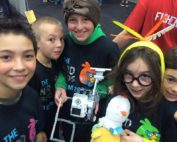
Ideas In Action: Personalized Learning Outcomes at Cornville Regional Academy

Key Takeaway
Nora Kern, Safal Partners Senior Associate
July 25, 2017
Personalized learning is gaining increasing attention in the education field. But what does personalized learning mean beyond greater use of technology? And most importantly, how can educators make personalized learning a truly meaningful experience for their school community?
A new study of personalized learning by RAND Corp. looked at the 31 charter and nine traditional schools nationwide that are part of the Bill & Melinda Gates Foundation’s Next Generation Learning Challenges’ program on Breakthrough School Models. The study found that students in personalized learning programs demonstrated higher math scores. Further, researchers found that the flexibility that is part of the charter schools model facilitates the implementation and scaling of personalized learning systems. On the flip side, the study also found that there was variation in personalized learning practices among schools. It noted that none of the schools “looked as radically different from traditional schools as theory might predict.”
Transforming a School through Personalized Learning
However, there are examples of personalized learning having a transformative effect on school operations. The National Charter School Resource Center recently interviewed faculty and parents at a rural charter school in central Maine that has fully integrated proficiency-based personalized learning into their curriculum.
Cornville Regional Charter School (CRCS) classes run on a flipped classroom approach, in which students independently progress through learning topics via videos or self-directed activities and come to the teacher for clarification and feedback.
According to Ashlee Savage, a Teaching Principal at CRCS,
“Our school looks very different than a traditional public school. One of the biggest pieces that you will see is learners moving about the building at any point throughout the day.”
Cornville students are not grouped into traditional grade levels. Instead, students move between classrooms where various learning facilitators address different learning targets students will need to cover as part of their individual learning plans.
CRCS constantly refines its operations to free it from traditional school constructs and instead focus on providing learners, “what they need, when they need it.” To learn more about the many ways that CRCS personalizes learning for students, gives real-time data to teachers, and provides detailed reports to parents, please see the full CRCS case study.
Read More Ideas In Action
Ideas in Action: Five Keys
Key Takeaway: Make classes accessible for the hardest to reach students. More than 10 percent of adults over age 25 in San Francisco do not have high school diplomas. [...]
Ideas in Action: Helping Students Find Their “True North” Through Social-Emotional Learning
Key Practice: Teaching students social-emotional skills that enable them to understand the perspectives of people from other backgrounds prepares them for college and the global workplace. Sharp minds. Big [...]
Ideas in Action: Personalized Learning Outcomes at Cornville Regional Academy
Ideas In Action: Personalized Learning Outcomes at Cornville Regional Academy Location: Cornville, ME Year opened: 2012 Grades served: K-8 Student enrollment: 144 Student [...]




